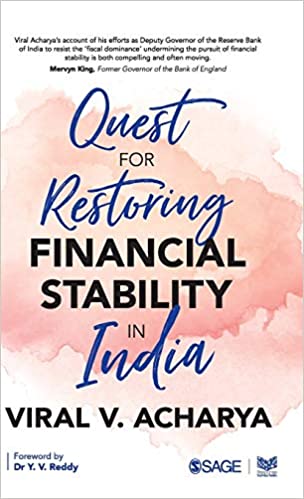As the Deputy Governor of the Reserve Bank of India (RBI) from 23 January 2017 to 23 July 2019, Viral Acharya may have had a relative short tenure in this position. But, it has been enough to distil some potent observations and suggestions pertaining to public finance and monetary policies. These appear in Quest for Restoring Financial Stability in India (Sage Publications). Hindsight offers a good scope for reflection. Lessons one learns in the process of introspection and observations one makes from the past, can be a boon for the future. Yes, lessons well learnt have their uses.
Acharya presents a holistic view of the economic and financial climate of India through the prism of its central bank. This book consists of a collection of articles and thoughts that he has used in the past. These were either for presentations or talks, or papers. However, in the book, he looks at these with more context. He fortifies his thoughts with research-based data as well as practical examples from the RBI and Indian context, and financial systems of other countries.

Fiscal dominance
Fiscal dominance is a crucial concept to which he allots a lot of space and explanation. “In economics, ‘fiscal dominance’ is traditionally defined as a state of the country in which large government debt and deficit (spending over and above revenues) prevent the monetary policy authority such as a central bank from meeting its mandated economic targets such as inflation, growth and employment. Instead, the central bank is kept primarily focused on ensuring that the government can roll over its debt and deficit and, in particular, that the government does not default on its liabilities,” he writes.
Throughout the book he quotes practical instances that show how fiscal dominance erodes the potential of the RBI. For instance, one of the most basic aspects is related to default disclosure norms. Despite recommendations to do so, a firm’s default on a bank loan is not something that is reported timely to the market. Given a pervasive influence that fiscal dominance in India has on financial sector regulation and policies, it is a natural corollary that it poses significant risks to the country’s long-term financial stability and growth. The book highlights this aspect in very definite terms.
Pointing out pain points
“The government, the public sector banks and the RBI became part of a big joint family (Hindu undivided family!) where no one kept proper accounts of what they were doing with each other and with the rest of the economy. The common belief was that they were all serving people” Y.V.Reddy, Former Governor of the RBI, says in the introduction. The spirit of this statement continues in the book.
Given the background of Dr. Acharya’s resignation, one tends to look for deeper nuances regarding the relationship between the RBI and the government. Indeed, the book very strongly argues for independence of the central bank from the executive, and it makes no qualms about it. There is an entire chapter that specifically focuses on the independence of the central bank, though the theme also pervades the entire book in some form or the other.
It is also interesting to observe that Urjit Patel, former Governor of the RBI, who also resigned before term, has chronicled his own stance in a book titled, “Overdraft: Saving the Indian Saver”. Both the books complement each other.

So, what’s the answer?
Does the book purport solutions? This is obviously one of the greatest topics of interest. Based on historical examples from India and world economies, based on his direct experience and research sources, Acharya constructs suggestions that could be classified as “surgical restructuring”. For every problem that he points out, he also has a basket of solutions that he enumerates. How effective and practical are these? Well, they are at least a good starting point for authorities, bureaucrats and the government to take notice.
The various chapters are derived from a series of talks and lectures delivered by Acharya himself. Some of the chapters are extremely simple and easy to understand, and even a lay person would understand them. Others may require a bit more understand of principles of economics and finance.
The book is definitely of academic interest, drawing references and allusions to theory and research. I think it is a must-read not only for those involved in economic and financial policy, but also students and researchers as well as common people who have an interest in finance and economics.
“As financial stability often requires enduring short-term pain for long-run growth, it is not easy to be its gatekeeper anywhere in the world, and certainly not so in India. To the extent I had some influence as a deputy governor of the RBI, I did not strike compromises on what really mattered for restoring financial stability, neither with the Governors nor with the Government of India. At times it wasn’t easy, but I continue to believe that it was worth fighting for. It was the right stance,” he writes. He may have played his role in the Quest for Restoring Financial Stability in India. Would others now take the baton?
Other books on finance and banking? Click here.




